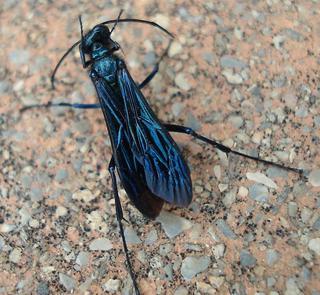
© Jason D. Roberts · 9
Chalybion californicum |
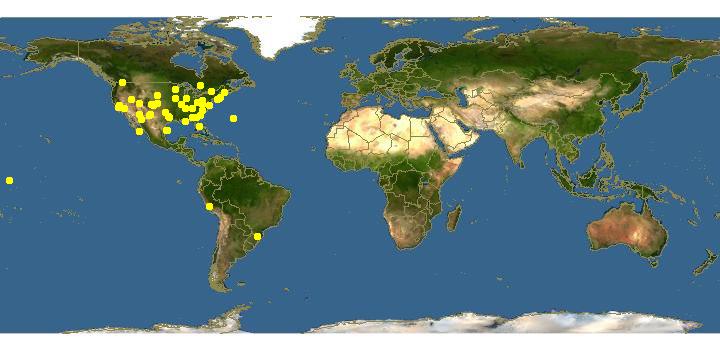
Click on map for details about points.
|
80x5 -
240x3 -
240x4 -
320x1 -
320x2 -
320x3 -
640x1 -
640x2
Set display option above.
Click on
images to enlarge. |
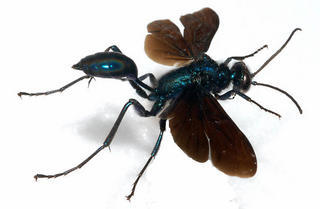
© Scott Nelson · 9
Chalybion californicum |
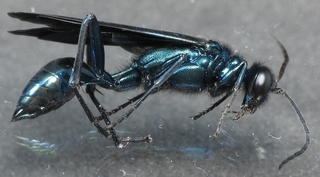
© Perry Babin · 9
Chalybion californicum, side |
|
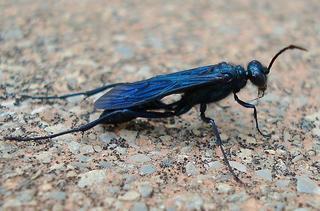
© Jason D. Roberts · 9
Chalybion californicum, side |
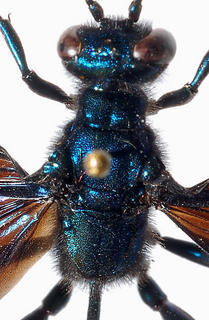
© Scott Nelson · 9
Chalybion californicum, thorax |
|
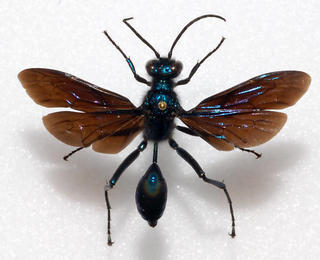
© Scott Nelson · 9
Chalybion californicum, top |
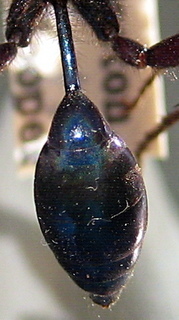
Native Bee Inventory and Monitoring Lab; Photographer: Erika Tucker · 9
Chalybion californicum - abdomen |
|
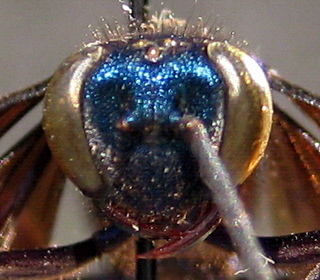
Native Bee Inventory and Monitoring Lab; Photographer: Erika Tucker · 9
Chalybion californicum - face |
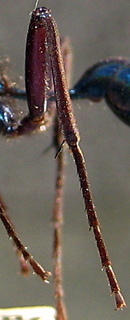
Native Bee Inventory and Monitoring Lab; Photographer: Erika Tucker · 9
Chalybion californicum - hindleg |
|
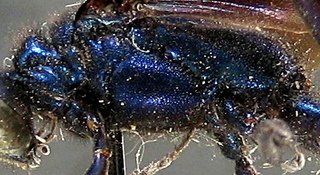
Native Bee Inventory and Monitoring Lab; Photographer: Erika Tucker · 9
Chalybion californicum - mesepisterum |
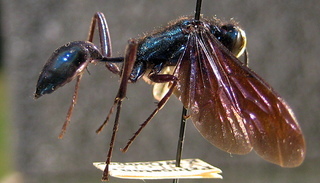
Native Bee Inventory and Monitoring Lab; Photographer: Erika Tucker · 9
Chalybion californicum - sideview |
|
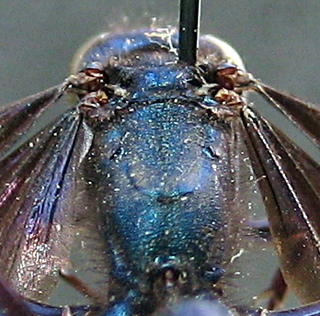
Native Bee Inventory and Monitoring Lab; Photographer: Erika Tucker · 9
Chalybion californicum - thorax closeup |
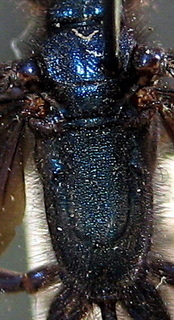
Native Bee Inventory and Monitoring Lab; Photographer: Erika Tucker · 9
Chalybion californicum - thorax |
|
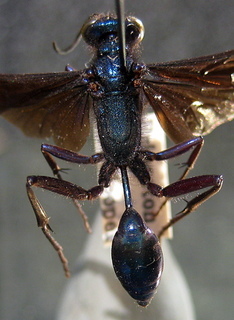
Native Bee Inventory and Monitoring Lab; Photographer: Erika Tucker · 9
Chalybion californicum - topview |
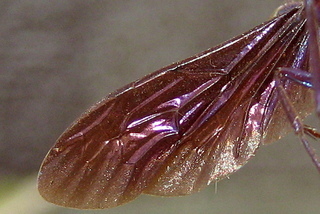
Native Bee Inventory and Monitoring Lab; Photographer: Erika Tucker · 9
Chalybion californicum - wing |
|
Overview |
Taken from:
Bohart, R.M., Menke, A.S. 1963. A Reclassification of the Sphecinae: With a Revision of the Nearctic Species of the Tribes Sceliphronini and Sphecini.
Male.—Average length 14 mm; erect hair of body black; wings uniformly dark violaceous; flagellomeres VII and VIII with oval fossulae apically; lateral teeth of elypeus larger and longer than median tooth.
Female.—Average length 16 mm; clypeal free margin with spatulate median lobe and broad lateral lobe; abdominal sternite V with a median U-shaped patch of sericeous pubescence, IV sometimes with a tiny sericeous patch.
|
|
|
Names | |
Chalybion californicum (Saussure)
(Figs. 6, 48, 63, 94, 105)
Sphex caerulea Johansson and Linnaeus, 1763, Amoenitates Acad., 6:412. Philadelphia, location of type unknown. Preoccupied by Sphex caerulea Linnaeus, 1758, a pompilid of the genus Priocnemioides, teste van der Vecht, 1959.
Sphex cyanea Fabricius, 1775, Systema Ent., p. 346. New name for Sphex cacrutea Johansson and Linnaeus, 1763; but preoccupied by Sphex cyanea Linnaeus, 1758, a Trichrysis.
Chalybion cyaneum Dahlbom, 1843, Hymen. Europaea, 1:22. Constitutes first placement in Chalybion (see generic type discussion).
Pelopeus (sic) californicus Saussure, 1867, Reise der ost. Freg. Novara, Zool., 2:26. Lectotype ♂, California (GENEVA). Present designation.
|
|
|
Geographic distribution | |
Distribution.—This species occurs throughout most of the United States and
ranges south into Mexico (fig. 6). It has been introduced into the Hawaiian Islands
and Bermuda.
|
|
|
Natural history | |
The tangled nomenclature of this species resulted from the use of the name caerulea by Linnaeus for two species of wasps. In an effort to correct the situation Fabricius renamed the latter of the two cyanea, which had unfortunately been used previously by Linnaeus for a Trichrysis. Dahlbom placed the species in the proper genus but attributed cyanea to Johannson and Linnaeus, 1763, and Linnaeus, 1767, instead of to Fabricius, 1775. The first available name for the species is Saussure’s californicum, 1867, as has been pointed out by Pate (1943), and his paper should be consulted for a complete synonymical bibliography.
Biology—Ran (1928a, 1928b) presented a full account of the biology of this species. C. californicum is an inquiline in the nest of Sceliphron caementarium. Since the ‘Sceliphron often lays an egg on the first spider (Schafer, 1949, stated this is not always true), it is essential for the Chalybion to remove all of the spiders to be sure of ridding the nest of the egg which might otherwise produce a larva to devour the guest. Also, Chalybion may open either end of the nest. The Chalybion carries water to the nest to soften the mud prior to opening a cell. After all of the old spiders are removed, C. californicum restocks with fresh ones, lays an egg on the last, and plugs the nest with mud taken from the nest after moistening it with water. According to Rau these wasps frequently adorn the nest with mud pellets. Excellent photos of Chalybion californicum nests have been published by Rau and Ran (1916b) and Muma and Jeffers (1945). Irving and unman (1935) recorded californicum using the black widow spider (Latrodectus mactans Fabricius) as prey.
The cocoon of C. californicum has a white silky outer covering, differing in this respect from the cocoon of 8. caementarium, which is uncovered and brown.
The gregarious nature of this wasp is indicated by the observations of Rau and Rau (l916a), who recorded clusters of both sexes at night or in cloudy daytime periods on the undersurface of overhanging rocks. Rau (1938) reported aggregations of a thousand specimens spending successive nights on the rafters of a house. F. U. Parker (conversation) observed about twenty of these wasps congregating each night for about two weeks under a porch roof at Reno, Nevada. The number of individuals congregating gradually diminished toward the end of the second week.
|
|
| Supported by | |
Updated: 2024-04-25 21:34:48 gmt
|